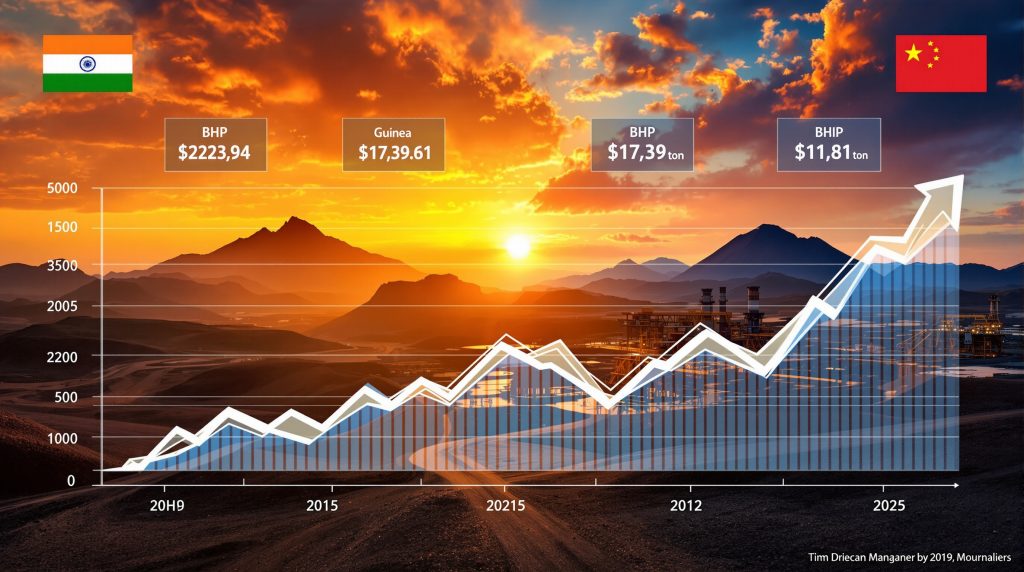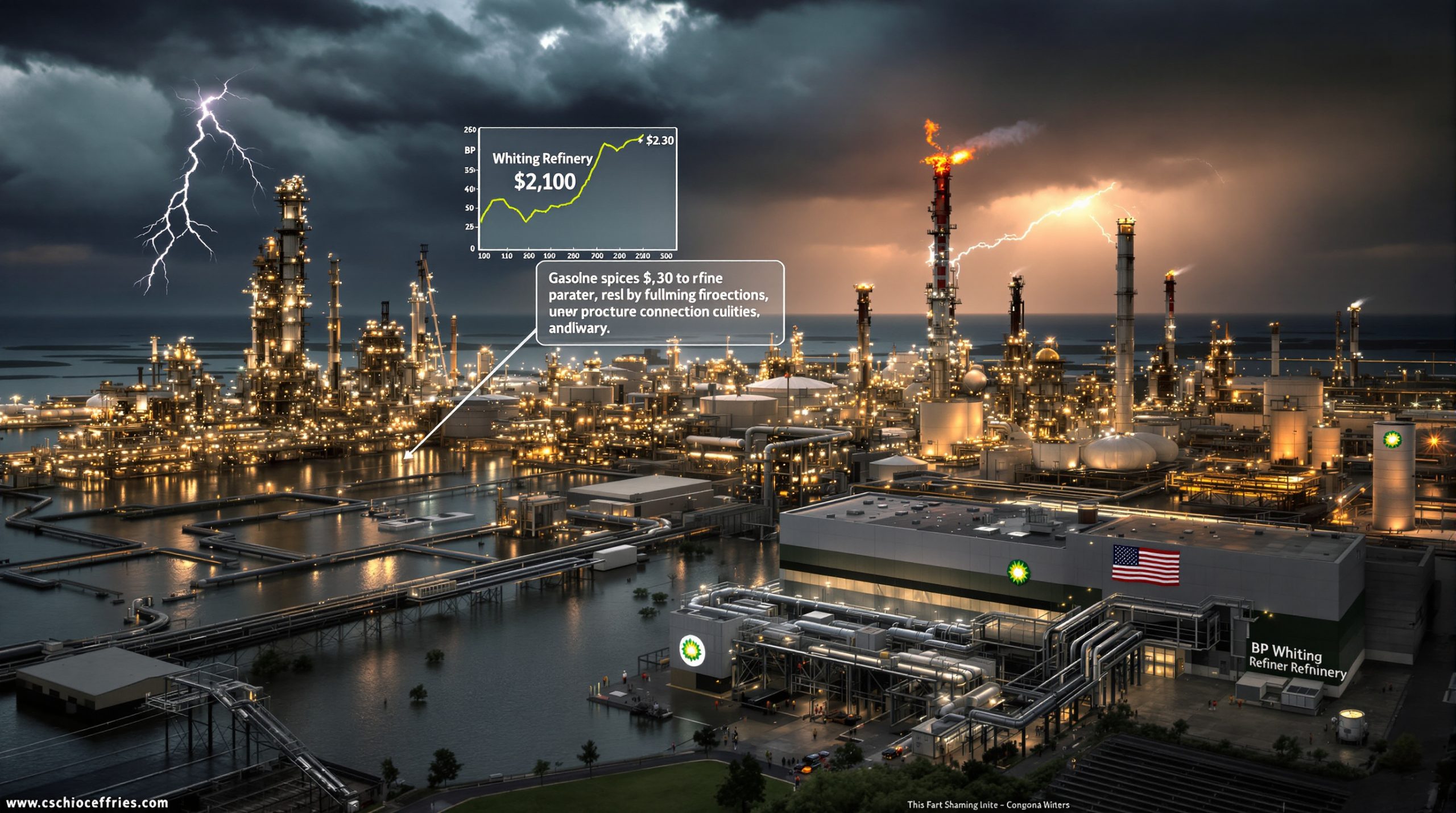Understanding BHP's Recent Financial Performance
BHP has reported a significant downturn in profits, with its underlying attributable profit dropping to $10.16 billion for the 2025 financial year—a 26% decline from the previous year. This represents the company's weakest financial performance since 2020, falling below analyst expectations as compiled by Visible Alpha, which had projected $10.22 billion.
The primary culprit behind this profit slump is the 19% decrease in average realized iron ore prices over the financial year. As iron ore constitutes BHP's main profit driver, this iron ore price trends has had an outsized impact on the company's bottom line.
Despite these challenges, BHP maintains a remarkable competitive advantage through its exceptionally low production costs. The company's Western Australian operations continue to extract iron ore at just $17.29 per metric ton—a figure that provides substantial protection against market downturns compared to the current benchmark price of $101.63 per ton on the Singapore Exchange.
"Despite the lower price for its main profit driver, BHP's iron ore mines in Western Australia state remain a prized asset," noted Clyde Russell, a Reuters columnist, highlighting the enduring value of these operations despite market headwinds.
The Cost Advantage Factor
BHP's production cost advantage can't be overstated. At $17.29 per ton, the company maintains one of the industry's lowest cost positions, creating a substantial buffer against price volatility. This competitive edge becomes increasingly important as the iron ore market faces multiple challenges:
- Margin protection: Even with prices dropping significantly from recent years, BHP maintains strong profitability
- Operational flexibility: Lower costs allow for continued production when higher-cost competitors might need to curtail output
- Strategic positioning: Enables BHP to weather market downturns while maintaining market share
This cost leadership position provides BHP with strategic options even as the broader iron ore market faces growing supply-demand imbalances.
What's Driving the Iron Ore Market Downturn?
The iron ore market has experienced a steady decline from its record high of $223.94 per ton reached in May 2021. This downward trajectory is evident in the year-by-year price performance: approximately $160 per ton in 2022, falling to $131 in 2023, rebounding slightly to $143 in 2024, before declining again to an average of $107.81 per ton year-to-date in 2025.
"The decline in prices has largely been driven by a flattening of demand in China," explains Russell. This analysis points to the critical role China plays in the global iron ore market, where it accounts for approximately 75% of seaborne imports.
Chinese steel production data reinforces this concern. July 2025 saw output drop to 79.66 million tons—a seven-month low representing a 4% decrease from June. The year-to-date production figure of 594.47 million tons for the first seven months of 2025 signals that annual output is likely to remain around the 1 billion ton mark—a level where it has stabilized for about five years.
Seasonal and Weather Factors
Beyond the structural plateauing of Chinese demand, seasonal factors are also influencing short-term market dynamics. "China's steel output dropped to a seven-month low in July…amid weaker construction demand because of high temperatures and heavy rains in some parts of the country," Russell noted.
These weather-related disruptions have compounded existing market challenges:
- Construction delays: Extreme weather conditions hampering building activity
- Reduced raw material demand: Steel mills adjusting production schedules in response to lower immediate needs
- Inventory management: Downstream consumers delaying purchases until weather conditions improve
While these seasonal factors may be temporary, they occur against a backdrop of more fundamental concerns about China's long-term steel demand trajectory.
How Serious Is the Supply-Demand Imbalance?
The iron ore market faces a potentially significant supply-demand mismatch, with major producers simultaneously expanding capacity despite flattening demand signals. BHP CEO Mike Henry confirmed that the company "is on track to increase its annual iron ore output from 290 million tons to 305 million." This expansion comes at a time when other major producers are also ramping up production.
Perhaps the most significant addition to global supply is the Simandou project in Guinea. This massive development is expected to begin shipping by the end of 2025, though it will take "a couple of years for Simandou to ramp up to its planned annual capacity" of 120 million tons.
This supply expansion creates considerable market risk, as noted by Russell: "The increasing risk is that the supply arrives ahead of the demand, much as it did in the last decade, driving the Singapore contract to an all-time low under $40 a ton in December 2015."
The Price Floor Mechanism
An important market dynamic to understand is the natural price floor created by production costs. According to industry analysis, "upwards of 100 million tons per annum of iron ore that is produced at a cost above $90 a ton" would become uneconomic if prices fall below this threshold.
This potential market adjustment mechanism works through several stages:
- Initial price pressure: Increasing supply pushes prices downward
- High-cost producer stress: Operations with costs above $90/ton face margin compression
- Production curtailment: Unprofitable mines reduce output or suspend operations
- Supply rationalization: Reduced global supply helps rebalance the market
While this adjustment process could eventually stabilize prices, it often involves significant volatility and financial stress for higher-cost producers.
Timing Mismatch Concerns
A critical concern for the iron ore market is the timing mismatch between supply expansion and potential demand growth. New supply from Simandou and existing producer expansions is arriving before potential iron ore demand insights from India and other markets has fully materialized.
This creates a precarious market situation:
- Near-term oversupply risk: Additional tons entering a market with stable demand
- Price pressure period: Potential for sustained lower prices until supply or demand adjusts
- Geographic market shift: Traditional China-focused supply chains adapting to new demand centers
How quickly this market rebalancing occurs will be a key determinant of medium-term iron ore price trends.
What Are the Growth Prospects Beyond China?
While China's steel production appears to have plateaued around 1 billion tons annually, industry leaders are looking to other markets for growth. BHP CEO Mike Henry specifically "singled out India as a growth opportunity" during a media call following the company's results release.
This focus on India represents a strategic pivot as the industry recognizes China's transition to a more mature steel market. "There is some optimism that even as China's steel output flattens that increasing production in other countries, especially India, will result in higher iron ore demand," Russell observed.
India's Emerging Opportunity
India presents a compelling growth case for iron ore producers for several reasons:
- Infrastructure development: Massive planned investments in roads, railways, and urban construction
- Manufacturing expansion: Government initiatives to boost domestic manufacturing capacity
- Urbanization trends: Continuing population shift from rural to urban areas driving construction demand
- Per capita steel consumption: Significant growth potential from current relatively low levels
However, the timing and pace of India's steel sector growth remain uncertain, particularly in relation to the imminent supply increases from projects like Simandou.
Global Steel Production Diversification
Beyond India, other emerging markets also represent potential growth opportunities for iron ore demand:
- Southeast Asian nations: Infrastructure development across multiple countries
- Middle East: Industrialization efforts and construction booms
- African development: Long-term potential as economies and infrastructure develop
This diversification of demand could eventually provide more balanced market dynamics, reducing the industry's heavy dependence on Chinese consumption patterns.
How Will This Impact BHP's Strategy?
BHP's strategic position in the iron ore market is significantly strengthened by its industry-leading production costs. At $17.29 per ton against a current market price of $101.63, the company maintains substantial profitability even in challenging market conditions.
"If there is a silver lining for BHP it's that any decline in prices may be limited as high-cost supply becomes uneconomic and leaves the market," Russell noted, highlighting the natural price floor mechanism that could protect more efficient producers.
The Diversification Imperative
BHP's profit decline underscores the vulnerability that comes from heavy reliance on a single commodity, even for a diversified miner. The company's performance swings with iron ore prices illustrate the importance of:
- Portfolio balancing: Ensuring robust revenue streams across multiple commodities
- Growth in other sectors: Pursuing opportunities in copper, nickel, and other future-facing metals
- Geographic diversification: Reducing dependence on single markets like China
For BHP, the current market dynamics emphasize the wisdom of its strategic pivot toward future-facing commodities while maintaining its position as a low-cost iron ore producer.
Market Positioning Strategy
In a potentially oversupplied market, low-cost producers like BHP have several strategic advantages:
- Volume flexibility: Ability to maintain or increase production despite lower prices
- Market share opportunity: Potential to gain share as higher-cost producers struggle
- Investment capability: Stronger financial position to continue operational improvements
- Acquisition potential: Financial strength to consider opportunistic purchases of distressed assets
These advantages could allow BHP to emerge from the current challenging market in a stronger competitive position, despite the near-term profit impact.
What Are the Key Market Indicators to Watch?
Investors and industry participants should monitor several key indicators to track the iron ore forecast insights and market evolution:
Chinese Steel Production Data
Monthly output figures provide crucial insights into demand stability. July 2025's output of 79.66 million tons (a seven-month low) signals potential weakness, though some of this may be attributable to seasonal factors. Continued monitoring will reveal whether this represents a temporary dip or a more concerning trend.
Key metrics to track include:
- Monthly production volumes: Compared year-over-year to account for seasonality
- Capacity utilization rates: Indicator of operational decisions at steel mills
- Inventory levels: Raw material and finished product stockpiles throughout the supply chain
- Regional production shifts: Changes in output across different Chinese provinces
These indicators collectively provide a comprehensive view of Chinese steel industry health.
Price Threshold Monitoring
The $90 per ton level represents a critical threshold where approximately 100 million tons of annual production becomes unprofitable. Price movements around this level could trigger significant supply responses:
- Below $90: Higher-cost producers face financial pressure, potential output reductions
- Sustained low prices: Mine closures or production suspensions become more likely
- Price volatility: Potential for rapid rebounds if supply exits the market too quickly
This threshold creates a natural, though sometimes painful, market adjustment mechanism.
Simandou Production Ramp-Up
The speed and volume of Simandou's production ramp-up will significantly impact 2025 iron ore market dynamics. With shipments expected to begin by the end of 2025 and a full capacity of 120 million tons, how quickly this material enters the market will influence price trajectories.
Monitoring factors include:
- Initial shipment volumes: Actual tonnage versus projections
- Infrastructure reliability: Port and rail performance
- Quality specifications: Grade consistency and impurity levels
- Customer integration: How smoothly material is incorporated into steel mill feed blends
The successful integration of Simandou material into the market represents one of the most significant supply-side developments in years.
Indian Steel Sector Growth
As BHP's CEO has highlighted, India represents a key growth opportunity that could partially offset flattening Chinese demand. Tracking Indian steel production growth rates, capacity expansion announcements, and raw material sourcing patterns will provide insights into this market's development pace.
Investor Advisory: Market conditions in the iron ore sector are experiencing significant transition, with supply growth potentially outpacing demand in the near term. While low-cost producers maintain substantial profitability buffers, market volatility may increase as the industry seeks a new equilibrium. Investors should carefully evaluate company-specific cost positions and diversification strategies when assessing sector investments.
Iron Ore Market Outlook Table: Price Trends and Key Factors (2021-2025)
| Year | Peak Price ($/ton) | Average Price ($/ton) | Key Market Factors |
|---|---|---|---|
| 2021 | $223.94 | ~$160 | Post-pandemic recovery, strong Chinese stimulus, supply constraints |
| 2022 | ~$160 | ~$120 | Supply chain normalization, early Chinese property sector concerns |
| 2023 | ~$131 | ~$110 | Chinese property sector weakness, production controls, global inflation |
| 2024 | ~$143 | ~$120 | Temporary demand recovery, policy support measures, supply disruptions |
| 2025 YTD | ~$107.81 | ~$105 | Flat Chinese demand, Simandou development, weather-related construction slowdowns |
FAQ: Iron Ore Market Outlook
Is BHP's profit decline primarily due to iron ore prices?
Yes, the 19% drop in average realized iron ore prices was the primary factor behind BHP's 26% profit decline. The company reported its lowest underlying profit in five years at $10.16 billion, falling short of analyst expectations of $10.22 billion. This performance highlights the company's continued dependence on iron ore despite its diversification efforts.
What is the current trend in iron ore pricing?
Iron ore prices have followed a general downward trajectory since peaking at $223.94 per ton in May 2021. Current 2025 prices are averaging around $107.81 per ton, significantly below previous years. This decline reflects fundamental changes in market dynamics, particularly the stabilization of Chinese steel production around 1 billion tons annually since 2020.
How might the Simandou project affect the iron ore market?
The Simandou project in Guinea is expected to add 120 million tons of annual capacity once fully operational. Initial shipments are anticipated by the end of 2025, with a multi-year ramp-up period to follow. This substantial new supply source could create significant downward pressure on prices, particularly if it arrives before demand growth from markets like India materializes at scale.
What factors could provide price support for iron ore?
Production costs create a natural price floor, with approximately 100 million tons of global production becoming uneconomic below $90 per ton. If prices fall below this threshold for a sustained period, higher-cost producers would likely curtail output, potentially leading to market rebalancing. Additionally, accelerated steel production growth in India or stronger-than-expected policy stimulus in China could provide demand-side support.
How does BHP's cost position compare to industry benchmarks?
BHP maintains an industry-leading production cost of $17.29 per ton, providing a substantial buffer against price declines. This cost advantage positions BHP to remain profitable even in significantly lower price environments that would challenge many competitors. The company's Australian iron ore leadership benefits from high-quality ore bodies, efficient infrastructure, and operational scale.
Key Insight: While BHP maintains a significant competitive advantage with its $17.29 per ton production cost, the company faces headwinds from both flattening demand in China and significant new supply entering the market. This combination creates potential for continued price pressure, highlighting the importance of cost leadership in maintaining profitability through market cycles.
Want to Identify the Next Major Mining Discovery Before the Market Does?
Discovery Alert's proprietary Discovery IQ model delivers instant notifications on significant ASX mineral discoveries, transforming complex geological data into actionable investment opportunities. Visit our discoveries page to understand why early identification of major mineral discoveries can lead to exceptional investment returns.




